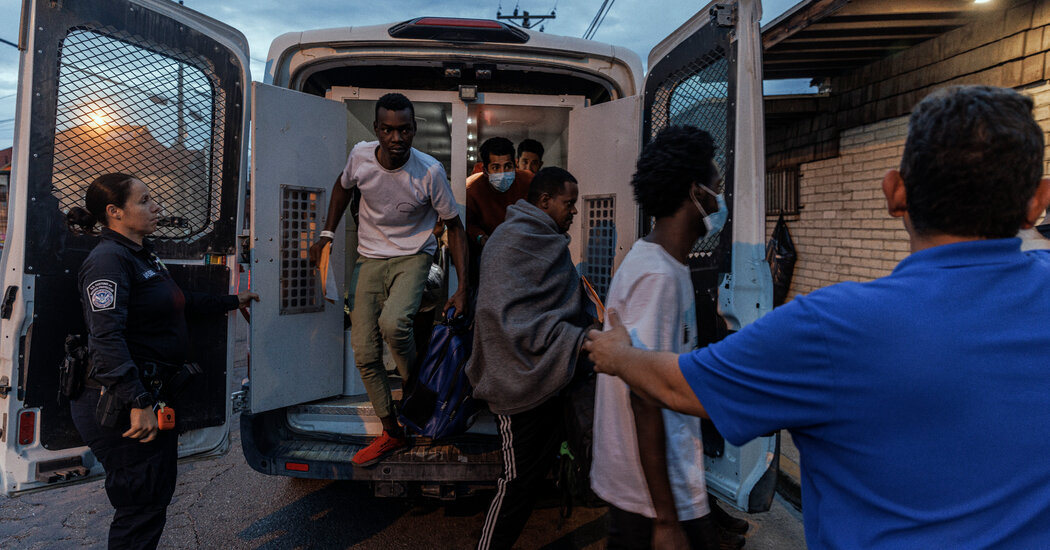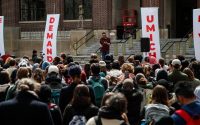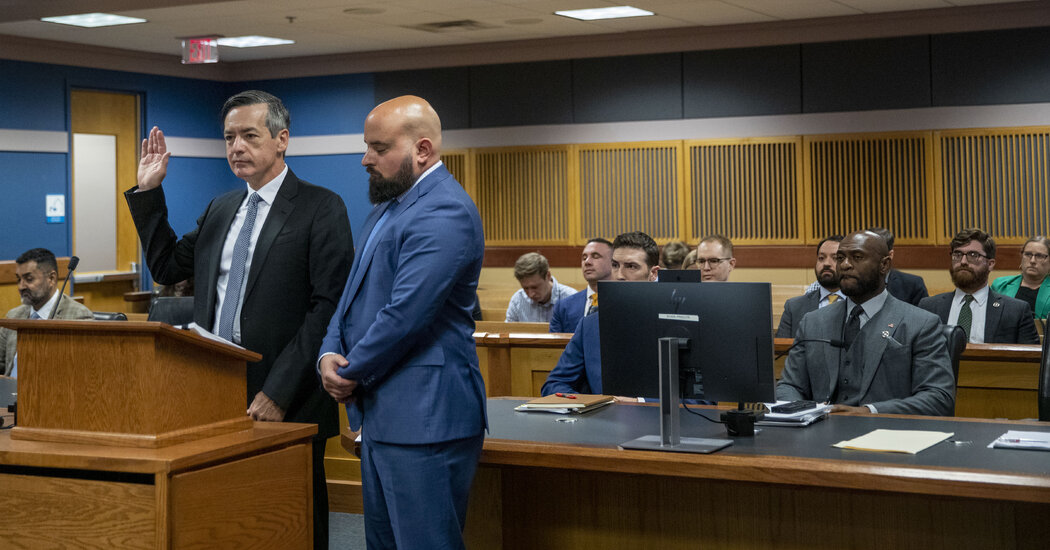Michigan Students Clash on Israel-Gaza War: Two Views, One Campus
They represent opposite corners at the University of Michigan, two sides of student activism who have hunkered down and almost never communicate.
Salma Hamamy is one of the most prominent faces of the pro-Palestinian movement on campus.
“One, two, three, four, open up the prison doors!” she shouts, bullhorn in hand, as she leads anti-Israel rallies in front of crowds of fellow students. “Five, six, seven, eight, Israel is a terrorist state!” Ms. Hamamy has helped lead over 20 protests since Hamas’s deadly attacks against Israel on Oct. 7 and the resulting bombardment of Gaza.
As she booms out calls for an end to war, or rails against a university administration that she believes has been tone deaf toward Palestinians, she knows she can look into the audience and find a familiar, though vexing, face: Josh Brown, a fellow student and Ms. Hamamy’s opposite in nearly every way.
Mr. Brown is perhaps the most fervent counterprotester at Michigan. A hard-and-fast supporter of Israel and Zionism, he shows up for almost every pro-Palestinian rally at his school, sometimes alone, always with a cellphone at the ready so he can record what he believes to be rampant antisemitism.
“These are extremists,” says Mr. Brown, speaking of the groups that Ms. Hamamy is a part of and helps lead. “What they are calling for is the destruction of my people.”
Mention her to Zionist, pro-Israel students and you may be met with a glare. When his name comes up among supporters of the Palestinian cause, looks of exasperation follow.
But during this painful season, with bitterness on campus mirroring emotions felt across the state of Michigan, a key battleground in the coming presidential election, one thing briefly united them. It took place after a heated protest, off to the side, with no one else around: a conversation, tense, tough and awkward at times, but also civil.
The Clash on Campus
In the 1920s, when most Ivy League schools, rife with antisemitism, capped yearly admissions of Jewish students, Michigan opened its arms and became a go-to fallback.
That legacy is plainly visible today. Data from Hillel International show the number of Jewish undergraduates at Michigan now stands near 5,000, among the largest of such campus populations in the country.
The Ann Arbor campus has also become a haven for students with Muslim roots. A recent campus survey estimated that there were nearly 2,500 Muslim undergraduate students at Michigan.
Over the years, the high numbers of Jews and Muslims have led to many efforts at outreach, and to simmering stress. But the temperature on campus has never felt like this.
A network of volunteers has been set up to ensure that Muslim women do not have to walk alone. There are Jewish students afraid to speak up in class, who live with roommates they had long considered friends. And students from both faiths worry about wearing anything identifying their faith.
Much of the heat has come from the vastly different interpretations of the chants shouted, symbols displayed and slogans used by protesters. Are calls for the veneration of martyrs and intifada antisemitic or legitimate signifiers of opposition? What about the comparison of Israeli leaders to Hitler?
Ms. Hamamy and other activists helped lead a student takeover of the Michigan administration building, which was met by a significant show of force by the police.
Citing campuswide safety fears, the administration canceled a student vote related to the war that would have called on the school to recognize that Gazans were “undergoing genocide.”
In January, the faculty’s Senate Assembly voted to approve a measure asking for divestment from Israel, furthering the campus split.
Ms. Hamamy celebrated the faculty vote. “Our voices are being heard,” she said.
To Mr. Brown, it was a gut punch.
“In the eyes of these faculty members, what does that make the person who supports Israel?” he asked. “They can have their views,” he added, “but at what cost to people like me?”
‘A Badge of Honor’
Ms. Hamamy was born in 2001 and grew up in Ann Arbor during an era when the racist backlash to the Sept. 11 terrorist attacks sparked fear among the Arab and Muslim communities. Her mother advised her to keep much of her Palestinian identity in the shadows.
She did as told. Then, she entered college.
Her freshman year coincided with the tumultuous attempts at racial reckoning in America in 2020. She began learning about the 1960s civil rights struggles and became active in the Black Lives Matter movement.
Social media played a potent role in pushing her transformation. On TikTok, X and Instagram, she took in the personal narrative of Palestinians in Gaza and their demands for change.
“Palestinians have been trying to resist for so long, and every single form of resistance that they’ve engaged in has always been shut down,” she said, summarizing the views she formed. But, she added, “you can’t expect your oppressors to voluntarily give you your freedom.”
By early 2023, Ms. Hamamy had become a stalwart in Michigan’s broad-based campus movement opposing Israel. She eventually became president of Michigan’s chapter of Students for Justice in Palestine, and helped form a coalition backed by 77 student organizations, including the anti-Zionist group Jewish Voice for Peace.
Speaking up and speaking out became the only way to calm her grief.
Backlash came swiftly. Over the last four months, there have been calls for her expulsion as a student. Her photo and personal information were posted online. She received death threats.
She took solace in the fact that others faced similar intimidation. “We’ve had several students be told that they should be raped, or that they don’t belong here,” she said. “That they’re infiltrating this campus, that we should go back to our countries. That we are a major threat.”
Asked what it was like to be the target of such hatred, she smiled and paused.
“I take it as a badge of honor,” she said.
Pulled Into the Fray
Mr. Brown was raised in suburban New York in a Jewish family, surrounded by a tight-knit Jewish community. But he didn’t pay much attention to Israel and its place in the world.
Until he went off to college.
Well before this school year, protests were familiar at the university, which he chose to attend with the vibrancy of its Jewish culture in mind. It was shocking, he said, walking to class, seeing clusters of fellow students demonstrating, hearing speeches that, to him, exhibited hatred toward Jews.
“This wasn’t just simply, ‘We don’t like the settlements,’ or even something as big as Israel’s treatment of the Palestinians,” he said. “It was clear calls for the erasure of Israel.”
“It was demonization.”
Mr. Brown began diving into Israel’s history. He devoured history books, Israeli newspapers, podcasts and YouTube presentations. He took a class on the Middle East conflict and joined a student group, Wolverine for Israel.
He came to believe that the overall discord between Israel and its neighbors was much more understandable than he had thought. Yes, Israel had its faults, he said. But “what I learned was that at every attempt at peace, the Palestinian leadership refused and would not do what is good for their population.”
“Their leaders have refused peace,” he added.
Like many others on campus, he felt that in the days and weeks after Oct. 7, the suffering of Israeli citizens, not only the killing but also the mutilation and rape, seemed to either be ignored, minimized or questioned by those who opposed Israel.
Ever since, Mr. Brown has barely missed showing up to counter a pro-Palestinian protest. He tries to stay on the outskirts or in sight of the police, keeping quiet, recording video and hoping not to draw attention. But almost everyone there knows who he is.
Sometimes he finds himself in the fray, drawn into verbal skirmishes, surrounded by angry protesters who don’t like being recorded and see him as an interloper barging into their space.
Sometimes, he withstands ugly tropes.
“Why are you here?” a demonstrator screamed at him one day. You already “own America!” she said. “You own everything!”
Seeking Middle Ground
Ms. Hamamy has come to expect Mr. Brown by now. “He shows up sometimes before me,” she said. “I have to hand it to him. He’s on top of it.”
Her view of Mr. Brown is different from many of her counterparts. When she sees him, she smiles and says hello.
“I’ll say this much,” Mr. Brown acknowledged with a grim wryness, “she’s much more cordial than many of the other people.”
At a demonstration last fall, Ms. Hamamy noticed some of her fellow protesters and Mr. Brown engaged in an argument. She called him over, asking, “What is it you want?”
As dusk neared, they walked alone to a nearby campus building and sat together on a bench. Maybe this would be a chance to recognize one another’s humanity.
He needed to know why anti-Israel protesters had not forcefully condemned the deaths of Israeli civilians.
She needed him to understand her view. It is a documented fact, she said: Israel is guilty of apartheid and genocide.
Seeking middle ground, they spoke of campus Islamophobia and antisemitism. The agitation was so high it felt as if violence could erupt on campus.
Ms. Hamamy and Mr. Brown exchanged phone numbers. She recalled leaving the conversation wary, convinced he didn’t get it. He remembered feeling “relatively optimistic.” Maybe, he thought, this could be the beginning of a dialogue between opposing sides.
That was months ago. Last week, after another protest, they spoke for a few seconds. Otherwise, they are no longer in touch.


